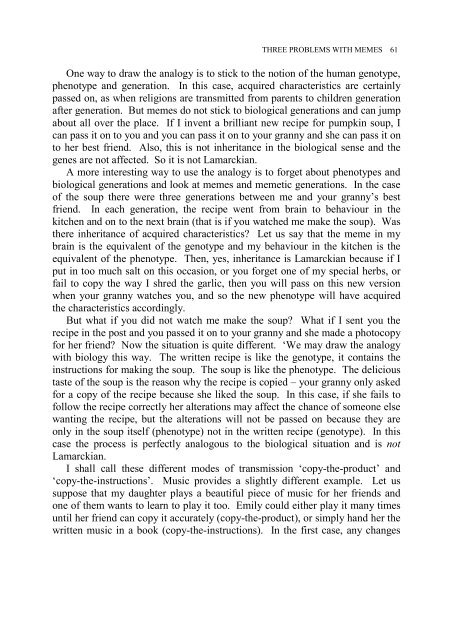The Meme Machine
TheMemeMachine1999
TheMemeMachine1999
- No tags were found...
Create successful ePaper yourself
Turn your PDF publications into a flip-book with our unique Google optimized e-Paper software.
THREE PROBLEMS WITH MEMES 61<br />
One way to draw the analogy is to stick to the notion of the human genotype,<br />
phenotype and generation. In this case, acquired characteristics are certainly<br />
passed on, as when religions are transmitted from parents to children generation<br />
after generation. But memes do not stick to biological generations and can jump<br />
about all over the place. If I invent a brilliant new recipe for pumpkin soup, I<br />
can pass it on to you and you can pass it on to your granny and she can pass it on<br />
to her best friend. Also, this is not inheritance in the biological sense and the<br />
genes are not affected. So it is not Lamarckian.<br />
A more interesting way to use the analogy is to forget about phenotypes and<br />
biological generations and look at memes and memetic generations. In the case<br />
of the soup there were three generations between me and your granny’s best<br />
friend. In each generation, the recipe went from brain to behaviour in the<br />
kitchen and on to the next brain (that is if you watched me make the soup). Was<br />
there inheritance of acquired characteristics? Let us say that the meme in my<br />
brain is the equivalent of the genotype and my behaviour in the kitchen is the<br />
equivalent of the phenotype. <strong>The</strong>n, yes, inheritance is Lamarckian because if I<br />
put in too much salt on this occasion, or you forget one of my special herbs, or<br />
fail to copy the way I shred the garlic, then you will pass on this new version<br />
when your granny watches you, and so the new phenotype will have acquired<br />
the characteristics accordingly.<br />
But what if you did not watch me make the soup? What if I sent you the<br />
recipe in the post and you passed it on to your granny and she made a photocopy<br />
for her friend? Now the situation is quite different. ‘We may draw the analogy<br />
with biology this way. <strong>The</strong> written recipe is like the genotype, it contains the<br />
instructions for making the soup. <strong>The</strong> soup is like the phenotype. <strong>The</strong> delicious<br />
taste of the soup is the reason why the recipe is copied – your granny only asked<br />
for a copy of the recipe because she liked the soup. In this case, if she fails to<br />
follow the recipe correctly her alterations may affect the chance of someone else<br />
wanting the recipe, but the alterations will not be passed on because they are<br />
only in the soup itself (phenotype) not in the written recipe (genotype). In this<br />
case the process is perfectly analogous to the biological situation and is not<br />
Lamarckian.<br />
I shall call these different modes of transmission ‘copy-the-product’ and<br />
‘copy-the-instructions’. Music provides a slightly different example. Let us<br />
suppose that my daughter plays a beautiful piece of music for her friends and<br />
one of them wants to learn to play it too. Emily could either play it many times<br />
until her friend can copy it accurately (copy-the-product), or simply hand her the<br />
written music in a book (copy-the-instructions). In the first case, any changes



